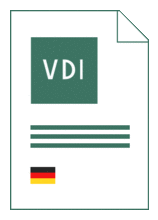
Technical rule [WITHDRAWN]
VDI 3405 Blatt 3:2015-12
Additive manufacturing processes, rapid manufacturing - Design rules for part production using laser sintering and laser beam melting
- German title
- Additive Fertigungsverfahren - Konstruktionsempfehlungen für die Bauteilfertigung mit Laser-Sintern und Laser-Strahlschmelzen
- Publication date
- 2015-12
- Original language
- German, English
- Pages
- 32
- Note
- The issuing body recommends using {0} DIN EN ISO/ASTM 52911-1:2020-05 , DIN EN ISO/ASTM 52911-2:2020-06 .
- Publication date
- 2015-12
- Original language
- German, English
- Pages
- 32
- Note
- The issuing body recommends using {0} DIN EN ISO/ASTM 52911-1:2020-05 , DIN EN ISO/ASTM 52911-2:2020-06 .
Product information on this site:
Quick delivery via download or delivery service
Buy securely with a credit card or pay upon receipt of invoice
All transactions are encrypted
Short description
Additive manufacturing processes have their origin in prototyping and are commonly known as rapid prototyping. Currently the properties of additively manufactured parts are good enough to be used as final products. Thus, additive manufacturing processes provide an additional manufacturing option besides conventional methods. They have the potential to reduce production time and costs while increasing functionality. Each manufacturing process has its specific advantages and disadvantages. These are well known with conventional manufacturing processes. Thus, they are taken into consideration adequately during the construction of devices and when choosing the actual manufacturing process. This treasure trove of experience is fairly available with additive manufacturing processes. This standard provides a base to consider additive manufacturing as an option to produce parts for specific purposes. It addresses design and production engineers. This standard described the specific characteristics of additive manufacturing processes and gives detailed and specific constructive recommendations for laser sintering of polymer parts and for beam melting of metallic parts.
Content
ICS
25.030
Also available in
Loading recommended items...
Loading recommended items...

